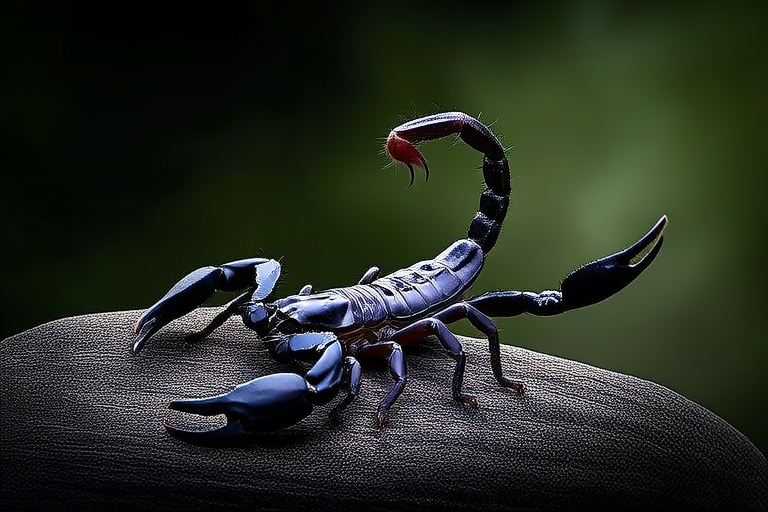Heterometrus spinifer: A Close Look at One of Nature’s Most Unique Species
Among the myriad creatures that inhabit our planet, few are as intriguing as Heterometrus spinifer. This species belongs to the family Scorpionidae and is renowned for its unique characteristics, making it a fascinating subject for both scientists and nature enthusiasts. In this article, we will explore the distinctive features of Heterometrus spinifer, its habitat, behavior, and ecological role. Additionally, we will compare it with other members of its genus and discuss the challenges it faces in the modern world.
Introduction to Heterometrus spinifer
Heterometrus spinifer, commonly known as the hairy forest scorpion, is a species native to Southeast Asia, particularly in regions such as Thailand, Malaysia, and Indonesia. It is easily recognizable by its long, segmented body and the presence of prominent spines on its tail. These spines serve multiple purposes, including defense against predators and aiding in prey capture. The scorpion’s body color ranges from dark brown to black, providing excellent camouflage in its natural habitat.
Physical Characteristics
The physical attributes of Heterometrus spinifer set it apart from other scorpions. Its body length can reach up to 14 centimeters, making it one of the larger species within the Heterometrus genus. The most striking feature is the pair of large pincers (chelae) located at the front of its body, which are used for capturing prey and defending itself. Another notable characteristic is the presence of sensory hairs along its body, which help it detect vibrations and changes in temperature, essential for survival in its environment.
The tail, or metasoma, of Heterometrus spinifer is equipped with a stinger at its tip, capable of injecting venom into its prey or attackers. However, the venom is generally mild and is primarily used for subduing small insects rather than posing significant danger to humans. The scorpion’s eyesight is relatively poor, so it relies heavily on its other senses for navigation and hunting.
Habitat and Behavior
Heterometrus spinifer thrives in dense forests and rocky areas, often found hiding under logs, stones, or in crevices. Its nocturnal nature makes it active during the night when temperatures are cooler and more conducive for hunting. The scorpion’s diet consists mainly of insects, spiders, and other small invertebrates. It uses its powerful pincers to grasp and crush its prey before delivering a paralyzing sting.
Like many scorpions, Heterometrus spinifer is solitary and territorial. Males engage in elaborate mating dances to attract females, a behavior that involves complex movements and signals. After mating, the female carries her eggs internally until they hatch, after which she continues to care for the young until they are ready to fend for themselves. This maternal care is uncommon among arachnids and highlights the species’ unique reproductive strategy.
Role in the Ecosystem
In its ecosystem, Heterometrus spinifer plays a crucial role as both predator and prey. As a top predator among invertebrates, it helps control populations of harmful insects, contributing to the overall health of its environment. On the other hand, it serves as food for various animals, including birds, reptiles, and other larger scorpions, thus forming part of the food chain. Understanding the interactions between Heterometrus spinifer and other species is vital for maintaining ecological balance.
Comparison with Other Heterometrus Species
Within the Heterometrus genus, there are several other species, each with its own set of characteristics. For example, Heterometrus laoticus is smaller and less aggressive, while Heterometrus longimanus is known for its exceptionally long legs, allowing it to move swiftly across open terrain. Comparatively, Heterometrus spinifer stands out due to its robust build and defensive spines, adaptations that have evolved over time to suit its specific habitat and lifestyle.
Despite these differences, all Heterometrus species share certain traits, such as their preference for humid environments and nocturnal habits. Studying the variations within the genus provides valuable insights into evolutionary processes and adaptation strategies.
Conservation Efforts and Threats
Unfortunately, like many species, Heterometrus spinifer faces numerous threats in the wild. Habitat destruction, primarily due to deforestation and urbanization, poses the greatest risk. As human settlements expand, the natural habitats of these scorpions shrink, leading to fragmentation and isolation of populations. Additionally, climate change may alter the conditions necessary for their survival, further complicating conservation efforts.
Efforts to protect Heterometrus spinifer include establishing protected areas and implementing sustainable land-use practices. Educational programs aimed at raising awareness about the importance of biodiversity also play a key role in ensuring the survival of this species. Collaboration between governments, non-governmental organizations, and local communities is essential to develop effective conservation strategies.
The Significance of Studying and Preserving Heterometrus spinifer
The study of Heterometrus spinifer and other species within the Heterometrus genus contributes significantly to our understanding of biodiversity and ecology. By examining how these creatures interact with their environment, we gain valuable knowledge that can be applied to broader ecological studies. Moreover, preserving Heterometrus spinifer ensures the maintenance of ecological balance, benefiting not only the scorpion but also the myriad of organisms that depend on it for survival.
Furthermore, the unique adaptations of Heterometrus spinifer offer potential applications in fields such as medicine and biotechnology. For instance, the venom produced by this scorpion could be studied for its medicinal properties, potentially leading to the development of new treatments for various ailments.
Conclusion
In conclusion, Heterometrus spinifer is a remarkable species with distinct features that make it a subject of great interest. From its physical characteristics and behavior to its role in the ecosystem, this scorpion exemplifies the diversity and complexity of life on Earth. By understanding and conserving Heterometrus spinifer, we not only protect an important member of our planet’s biodiversity but also contribute to the overall health and sustainability of our ecosystems.
